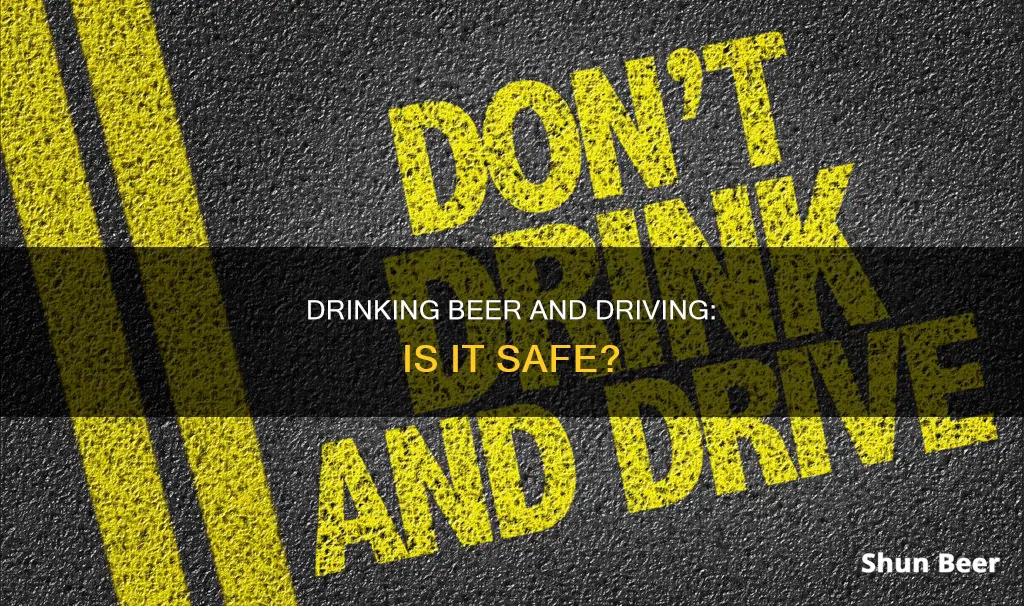
Drinking and driving is a dangerous combination that can lead to serious consequences, including injuries, legal penalties, and even fatalities. While the legal blood alcohol content (BAC) limit for driving is typically set at 0.08%, the number of drinks to reach this limit varies from person to person. Factors such as body weight, gender, metabolism, and the type of drink consumed influence how alcohol affects an individual. A pint of beer, containing approximately 2.3 units of alcohol, can impact people differently. It is crucial to understand these factors and personal alcohol limits to make informed decisions about drinking and driving.
| Characteristics | Values |
|---|---|
| Amount of alcohol in a pint of beer | 2.3 units of alcohol |
| Legal alcohol limit for driving in the UK | 80 milligrams of alcohol per 100 millilitres of blood or 35 micrograms of alcohol per 100 millilitres of breath |
| Time taken for alcohol to leave the body | Approximately one unit per hour |
| Time taken for alcohol from one pint of beer to leave the system | 2-3 hours |
| Factors affecting alcohol tolerance | Age, weight, gender, genetics, medications, and health conditions |
What You'll Learn

Alcohol limits and their variability
Alcohol limits refer to the maximum amount of alcohol a person can consume without experiencing significant impairment. These limits vary depending on several factors, and understanding them is crucial to avoid driving under the influence.
Firstly, let's understand what constitutes "one pint". A pint of beer contains approximately 2.3 units of alcohol. This amount can significantly impact individuals, and this effect varies depending on factors such as weight, gender, and metabolism.
The legal alcohol limit for driving in the UK is 80 milligrams of alcohol per 100 millilitres of blood or 35 micrograms of alcohol per 100 millilitres of breath. However, it is not possible to determine if you are over this limit after just one pint of beer, as various factors, including weight, metabolism, and the strength of the beer, come into play.
The amount of alcohol individuals can consume before reaching the legal limit varies. For example, a 180-lb man may be able to drink 3.5 regular 12-ounce beers in an hour and maintain a Blood Alcohol Concentration (BAC) under the legal limit of 0.08%. On the other hand, a 140-lb woman may only be able to consume 2.5 beers in the same timeframe while staying under the same limit.
It is important to note that these numbers are general estimates, assuming an average beer with a 5% alcohol by volume (ABV) level, and they do not consider other factors such as metabolic rate. Different types of alcoholic drinks also affect people differently. For instance, hard liquor may make some individuals feel "drunker" faster than beer.
In conclusion, it is essential to understand that alcohol limits vary from person to person and are influenced by various factors. Even one pint of beer can affect individuals differently. It is always safer to avoid driving after consuming any amount of alcohol and to give your body enough time to process and eliminate it from your system.
Beer Without Refrigeration: Is It Safe to Drink?
You may want to see also

Factors affecting alcohol tolerance
It is not advisable to drive after drinking any amount of alcohol, including one pint of beer. Even a single pint of beer can affect individuals differently, and it is not possible to determine whether you are over the legal limit after just one pint. The amount of alcohol in your system depends on various factors, and driving under the influence of alcohol can lead to legal consequences such as fines, license suspension, or imprisonment.
Now, let's delve into the factors that affect alcohol tolerance:
Age, Weight, and Gender
Younger individuals and those with lower body weight tend to have lower alcohol tolerance. Women generally have lower alcohol tolerance than men due to differences in body composition and metabolism. Women have lower levels of alcohol dehydrogenase, the enzyme that metabolizes alcohol, leading to higher blood alcohol content.
Genetics and Ethnicity
Genetics play a significant role in alcohol tolerance. Individuals with a family history of alcoholism or alcohol use disorders are at an increased risk of developing similar issues. Additionally, certain ethnicities, such as people of Asian or Native American descent, tend to have slower metabolic rates due to lower enzyme levels, resulting in higher intoxication levels.
Body Size and Composition
Body size and composition influence how alcohol is absorbed and distributed in the body. Smaller individuals with lower body mass will generally become impaired more quickly. Since fat does not absorb alcohol, people with higher body fat percentages will experience a higher concentration of alcohol in their lean tissues.
Rate of Consumption and Amount of Alcohol
The amount of alcohol consumed and the speed of consumption directly impact blood alcohol content (BAC). Drinking a significant amount of alcohol in a short period will lead to a higher BAC.
Food Intake
Consuming food before or while drinking can slow the absorption of alcohol into the bloodstream. Eating a larger meal closer to the time of drinking can lower the peak blood alcohol concentration. However, the type of food (carbohydrates, fat, or protein) does not seem to have a significant influence on BAC.
Carbonated Beverages
Mixing alcohol with carbonated beverages, such as cola or tonic water, speeds up the absorption of alcohol into the bloodstream. This also applies to drinks like champagne and wine coolers.
Medications and Drug Usage
Mixing alcohol with certain medications or drugs can have hazardous consequences. Over-the-counter medications like aspirin, ibuprofen, or acetaminophen, as well as prescription drugs, can impact the body's ability to process alcohol and lead to increased impairment.
Health and Mental State
Being sick, tired, or experiencing strong emotions like anger, fear, or loneliness can hasten impairment. Lack of sleep reduces tolerance, and mental health issues like stress, anxiety, or depression may decrease enzyme levels, leading to higher intoxication.
Metabolism
Metabolic rate refers to how quickly the body can process and remove alcohol. A higher metabolic rate lowers BAC, allowing individuals to drink more alcohol without feeling its effects as strongly.
Beer and Amox-Clav: Is It Safe to Drink?
You may want to see also

Alcohol units in different drinks
It is important to understand your alcohol limits, the legal alcohol limit for driving, and the signs of alcohol impairment to avoid putting yourself and others at risk. Alcohol units are a simple way to understand the quantity of pure alcohol in a drink. One unit is 10ml (millilitres) or 8g (grams) of pure alcohol. Alcoholic drinks come in different strengths and sizes, so units help to indicate how strong a drink is.
- A glass of wine contains 2.3 units (175ml glass, 13% ABV)
- A pint of beer contains 2.3 units (1 pint, 4% ABV)
- A pint of cider contains 2.6 units (1 pint, 4.5% ABV)
- A shot of spirits contains 1 unit (1 shot, 40% ABV)
- A glass of champagne contains 1.5 units (125ml glass, 12% ABV)
- An average bottle of alcopop contains 1.1 units (275ml bottle, 4% ABV)
It is important to note that these values are averages and will vary depending on the drink's strength and size. The alcoholic content of similar types of drinks can vary significantly. For example, some ales are 3.5% ABV, while stronger continental lagers and craft beers can be 5% or 6% ABV, or even higher.
The same is true for wine. Some stronger wines can exceed 14% ABV, and wine, on average, has been getting stronger in recent years. Thus, it is always recommended to check the label or ask at the bar to know the exact alcohol content.
Additionally, pubs and bars often serve larger wine servings. A large glass of wine, at 250ml, likely contains at least three units of alcohol. Therefore, drinking three large glasses is equivalent to drinking a whole bottle (750ml), which can have serious health consequences.
It is also worth noting that the UK Chief Medical Officers recommend that adults do not regularly drink more than 14 units per week. If you do drink 14 units in a week, it is advised to spread your drinking over three or more days.
Beer and Buspirone: Is It Safe to Mix?
You may want to see also

Legal alcohol limit for driving
Drinking and driving is a dangerous crime. Even if you don't feel the effects of alcohol, your blood alcohol content (BAC) may exceed your region's legal limit. It is important to note that everyone has a different alcohol tolerance, and factors such as age, weight, gender, genetics, medications, and health conditions can influence alcohol tolerance.
In the UK, the legal alcohol limit for driving is 80 milligrams of alcohol per 100 millilitres of blood or 35 micrograms of alcohol per 100 millilitres of breath. This limit is in place to prevent people from driving under the influence of alcohol, which can impair judgment and coordination and increase the risk of accidents. It is crucial to understand these limits and avoid driving if you have consumed any alcohol.
In California, the legal limit is set at 0.08% BAC if you are over 21 years old. For those under 21, the limit is much lower at 0.01%. This means that even a small amount of alcohol can put someone under 21 over the legal limit. It is illegal to drive with a BAC of 0.04% or higher if you have a commercial driver's license or are driving a passenger for hire.
The "one drink an hour" rule is a common misconception. This rule suggests that consuming 1¼ ounces of hard liquor, one beer, or one glass of wine per hour will keep your BAC below the legal limit. However, this rule may not be effective as everyone's body processes alcohol differently based on factors such as metabolism, weight, and body composition.
To stay within the legal alcohol limit, it is recommended to take precautions such as eating before drinking, staying hydrated, avoiding drinks with high alcohol content, and planning alternative transportation. It is also important to recognize the signs of alcohol impairment, which include impaired balance and coordination, impaired judgment, and drowsiness.
Beer and Rosacea: What's the Connection?
You may want to see also

How long does it take for alcohol to leave the body?
It's important to note that there are many factors that influence how long it takes for alcohol to leave the body. These include age, gender, weight, body composition, metabolism, and whether food was consumed with the alcohol.
On average, it takes about one hour for the body to metabolize one standard drink. However, this can vary depending on individual factors such as weight, height, gender, and body composition. For example, women tend to have lower alcohol tolerance than men due to differences in body composition and metabolism.
The rate at which alcohol is eliminated from the body also depends on the type of test used. A blood test can detect alcohol in the bloodstream for up to 6 to 12 hours after the last drink. A urine test can detect alcohol for approximately 12 to 24 hours, or up to 3 to 5 days with a more specialized test. Alcohol can be detected in saliva for 12 to 24 hours, and in hair follicles for up to 90 days.
It's worth noting that the legal alcohol limit for driving in the UK is 80 milligrams of alcohol per 100 millilitres of blood or 35 micrograms of alcohol per 100 millilitres of breath. It is not advisable to drive after drinking any amount of alcohol, as even one pint of beer can affect individuals differently. It is always safer to wait until you are sure that the alcohol has left your system before driving.
Enjoying Beer at VA Beach: What You Need to Know
You may want to see also
Frequently asked questions
It is not advisable to drive after drinking any amount of alcohol, as even one pint of beer can affect individuals differently depending on various factors. It is important to understand your alcohol limits, the legal alcohol limit for driving, and the signs of alcohol impairment to avoid putting yourself and others at risk.
Alcohol tolerance varies from person to person and is influenced by age, weight, gender, genetics, medications, and health conditions. Younger individuals, those with lower body weight, and women tend to have lower alcohol tolerance.
Signs of alcohol impairment include impaired balance and coordination, impaired judgment and decision-making, and drowsiness or fatigue. If you exhibit any of these signs, you should not drive and arrange for alternative transportation.







